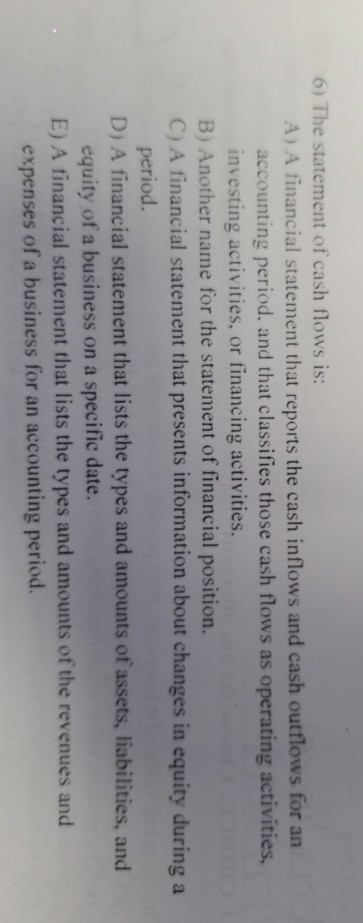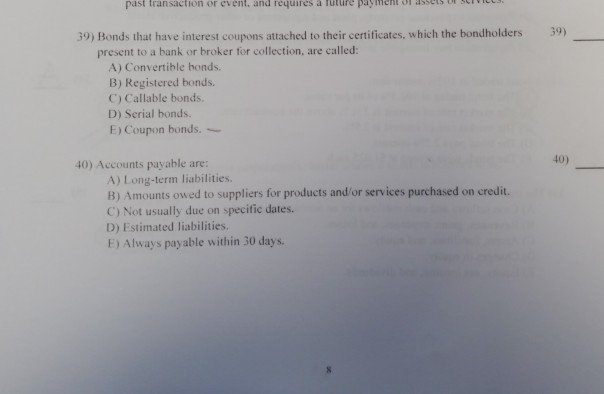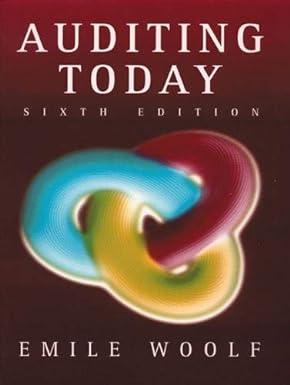Answered step by step
Verified Expert Solution
Question
1 Approved Answer
6) The statement of cash flows is: A) A financial statement that reports the cash inflows and cash outflows for an accounting period, and that







6) The statement of cash flows is: A) A financial statement that reports the cash inflows and cash outflows for an accounting period, and that classifies those cash flows as operating activities, investing activities, or financing activities. B) Another name for the statement of financial position. C) A financial statement that presents information about changes in equity during a period. D) A financial statement that lists the types and amounts of assets, liabilities, and equity of a business on a specific date. E) A financial statement that lists the types and amounts of the revenues and expenses of a business for an accounting period. 11) Sinking fund bonds: A) Require the issuer to set aside assets at specified amounts to retire the bonds at maturity. B) Are registered bonds. C) Require equal payments of both principal and interest over the life of the bond issue. D) Decline in value over time. E) Are bearer bonds. 14) Retained earnings: A) Are never adjusted for anything other than net income or dividends. B) Represents the amount shareholders are guaranteed to receive upon company liquidation C) Generally consists of a company's cumulative net income less any net losses and dividends declared since its inception. D) Represent an amount of cash available to pay shareholders. E) Can only be appropriated by setting aside a cash fund. 28) The board of directors of a corporation: A) May not also be executive officers of the corporation, due to the separate entity principle. B) Do not have the power to bind the corporation to contracts, due to lack of mutual agency C) Are elected by the corporate registrar. D) Are responsible for day-to-day operations of the business. E) Are responsible for and have final authority for managing corporate activities. 35) The statement of cash flows reports: A) Cash inflows and cash outflows for an accounting period. B) Revenues, gains, expenses, and losses. C) Assets, liabilities, and equity. D) Changes in equity. E) Equity, net income, and dividends. 47) A proxy is: A) The right of common stockholders to protect their proportionate interests in a corporation by having the first opportunity to purchase additional shares of common stock issued by the corporation B) A document that delegates a stockholder's voting rights to an agent. C) An arbitrary amount assigned to no-par stock by the corporation's board of directors D) A contractual commitment by an investor to purchase unissued shares of stock E) An amount of assets defined by state law that stockholders must invest and leave invested in a corporation. past transaction or event, and requires a future payment si se DE STILLS 39) 39) Bonds that have interest coupons attached to their certificates, which the bondholders present to a bank or broker for collection, are called: A) Convertible bonds. B) Registered bonds. C) Callable bonds. D) Serial bonds. E) Coupon bonds. - 40) 40) Accounts payable are: A) Long-term liabilities. B) Amounts owed to suppliers for products and/or services purchased on credit. C) Not usually due on specific dates. D) Estimated liabilities. E) Always payable within 30 days
Step by Step Solution
There are 3 Steps involved in it
Step: 1

Get Instant Access to Expert-Tailored Solutions
See step-by-step solutions with expert insights and AI powered tools for academic success
Step: 2

Step: 3

Ace Your Homework with AI
Get the answers you need in no time with our AI-driven, step-by-step assistance
Get Started


